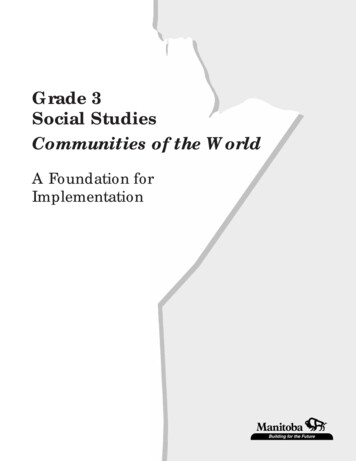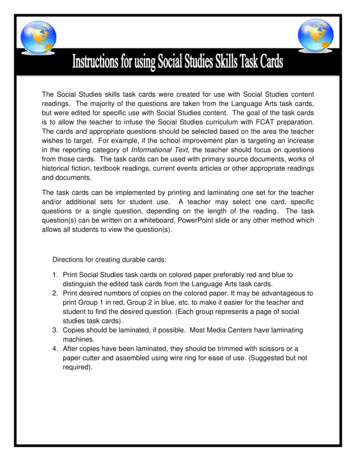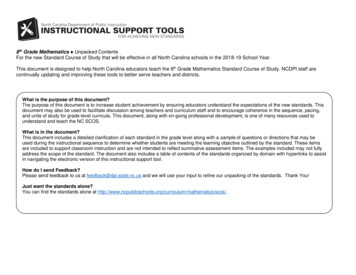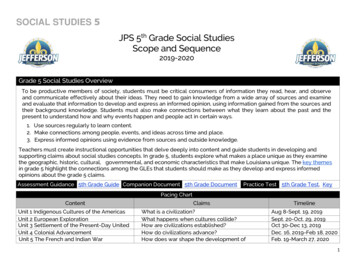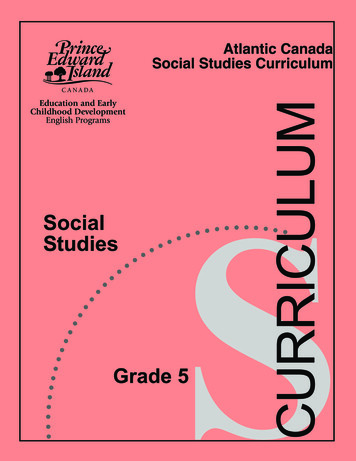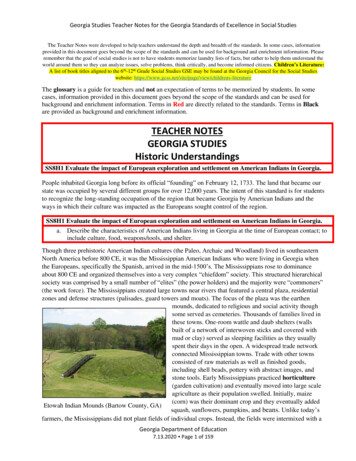
Transcription
Georgia Studies Teacher Notes for the Georgia Standards of Excellence in Social StudiesThe Teacher Notes were developed to help teachers understand the depth and breadth of the standards. In some cases, informationprovided in this document goes beyond the scope of the standards and can be used for background and enrichment information. Pleaseremember that the goal of social studies is not to have students memorize laundry lists of facts, but rather to help them understand theworld around them so they can analyze issues, solve problems, think critically, and become informed citizens. Children’s Literature:A list of book titles aligned to the 6th-12th Grade Social Studies GSE may be found at the Georgia Council for the Social Studieswebsite: ratureThe glossary is a guide for teachers and not an expectation of terms to be memorized by students. In somecases, information provided in this document goes beyond the scope of the standards and can be used forbackground and enrichment information. Terms in Red are directly related to the standards. Terms in Blackare provided as background and enrichment information.TEACHER NOTESGEORGIA STUDIESHistoric UnderstandingsSS8H1 Evaluate the impact of European exploration and settlement on American Indians in Georgia.People inhabited Georgia long before its official “founding” on February 12, 1733. The land that became ourstate was occupied by several different groups for over 12,000 years. The intent of this standard is for studentsto recognize the long-standing occupation of the region that became Georgia by American Indians and theways in which their culture was impacted as the Europeans sought control of the region.SS8H1 Evaluate the impact of European exploration and settlement on American Indians in Georgia.a. Describe the characteristics of American Indians living in Georgia at the time of European contact; toinclude culture, food, weapons/tools, and shelter.Though three prehistoric American Indian cultures (the Paleo, Archaic and Woodland) lived in southeasternNorth America before 800 CE, it was the Mississippian American Indians who were living in Georgia whenthe Europeans, specifically the Spanish, arrived in the mid-1500’s. The Mississippians rose to dominanceabout 800 CE and organized themselves into a very complex “chiefdom” society. This structured hierarchicalsociety was comprised by a small number of “elites” (the power holders) and the majority were “commoners”(the work force). The Mississippians created large towns near rivers that featured a central plaza, residentialzones and defense structures (palisades, guard towers and moats). The focus of the plaza was the earthenmounds, dedicated to religious and social activity thoughsome served as cemeteries. Thousands of families lived inthese towns. One-room wattle and daub shelters (wallsbuilt of a network of interwoven sticks and covered withmud or clay) served as sleeping facilities as they usuallyspent their days in the open. A widespread trade networkconnected Mississippian towns. Trade with other townsconsisted of raw materials as well as finished goods,including shell beads, pottery with abstract images, andstone tools. Early Mississippians practiced horticulture(garden cultivation) and eventually moved into large scaleagriculture as their population swelled. Initially, maize(corn) was their dominant crop and they eventually addedEtowah Indian Mounds (Bartow County, GA)squash, sunflowers, pumpkins, and beans. Unlike today’sfarmers, the Mississippians did not plant fields of individual crops. Instead, the fields were intermixed with aGeorgia Department of Education7.13.2020 Page 1 of 159
Georgia Studies Teacher Notes for the Georgia Standards of Excellence in Social Studiesvariety of plants. Tall corn stalks provided a shield against damaging sun rays for ground level crops.Tobacco was planted for ritual usage. They did not abandon hunting and gathering, however. Using bows andarrows and chert (sedimentary rock) knives, bone evidence indicates that they hunted deer, rabbit, muskrat,beaver, raccoon, and turkey. Turtle and fish were also a part of their diet. They gathered seasonal fruits,including plums, grapes, blackberries, and raspberries as well as a variety of nuts. The Mississippiansimproved on the stone tools of previous cultures to use in hunting, farming, and human conflict. Afterinteracting with the Spanish under Hernando DeSoto’s leadership in the mid-1500’s, many Mississippianssuccumbed to disease and the group eventually reorganized into the historic tribes of the Creek and theCherokee.Glossary Chert - sedimentary rock used by the American Indians to make knives. Commoners - the work force in the Mississippian culture. Elites - the power holders in the Mississippian culture. Horticulture - garden cultivation; important to the Mississippian culture. Maize - another term for corn. Mississippian Indians (800 C.E.-1600 C.E.) - the last major prehistoric Native American culture inGeorgia; known for being large scale framers and mound builders who traded throughout North America. Okefenokee Swamp - the largest swamp in North America; was the home to many Native Americans anda location for Spanish missions. Wattle and Daub - walls built of a network of interwoven sticks and covered with mud or clay; used byearly American Indian cultures and European settlers.Resources:King, Adam. “Mississippian Period: Overview.” New Georgia Encyclopedia. 11 October 2016. Web.13 October 2016. y-archaeology/mississippianperiod-overviewThis article provides a detailed overview of the main facets of the Mississippian culture from 800 CEto 1600 CE. Titles of other informative articles are provided.Smith, Marvin T. “Late Prehistoric/Early Historic Chiefdoms (ca. A.D. 1300-1850).” New GeorgiaEncyclopedia. 02 August 2016. Web. 13 October hiefdoms-ca-ad-1300-1850This article details the political organizations of the American Indians living in Georgia during theMississippian period. Titles of other informative articles are provided.SS8H1 Evaluate the impact of European exploration and settlement on American Indians in Georgia.b. Explain reasons for European exploration and settlement of North America, with emphasis on theinterests of the Spanish and British in the Southeastern area.European nations had different reasons for exploring North America, specifically the Southeast. Economiccompetition between the French, the Dutch, the Spanish, and the English was a primary cause for theexploration of North America. Each desired to build a large empire that would create political and economicdominance in the world.France, interested in developing a serious fur trade in North America, was primarily interested in Louisiana,the Ohio Valley, and Canada. However, in 1562, Jean Ribault explored Georgia’s coastline in search of theideal location on which to establish a French colony. He chose a South Carolina location instead. FrenchGeorgia Department of Education7.13.2020 Page 2 of 159
Georgia Studies Teacher Notes for the Georgia Standards of Excellence in Social StudiesProtestants eventually moved from South Carolina into Georgia as they sought religious freedom in the1730’s.Spain was interested in North America (particularly the Southeast) for the three G’s: God, Gold and Glory.Converting the American Indians to Christianity, filling the Spanish monarch’s treasury with gold, andseeking personal fortune and fame were the goals of Spanish conquistadores. The Spanish never realizedthe need for self-sustaining colonies as they were preoccupied with their search for gold.England desired to create permanent colonies in North America to support the economic policy ofmercantilism (the economic policy in which a country seeks to export more than it imports). The “mothercountry” developed colonies that produced raw materials that would be shipped “home” for production intofinished products. These products would be shipped back to the colony for purchase by the colonists. Otherreasons for creating colonies included a desire for “religious freedom” and a place to begin a “new life”.Glossary Mercantilism - the English economic policy focused on exporting more than importing. Missions - churches set up by the Spanish in hopes of converting Native Americans to Christianity.Resources:Worth, John E. “Spanish Exploration.” New Georgia Encyclopedia. 10 March 2016. Web. 13 October2016. y-archaeology/spanish-explorationThis article provides insight into the numerous Spanish expeditions in southeastern North America.Titles of other informative articles are provided.SS8H1 Evaluate the impact of European exploration and settlement on American Indians in Georgia.c. Evaluate the impact of Spanish contact on American Indians, including the exploration of HernandoDeSoto and the establishment of Spanish missions along the barrier islands.Spanish contact had a dramatic impact on the American Indian culture inGeorgia. Hernando DeSoto, the first known European explorer in Georgia, wasdirectly responsible for starving and killing a large number of American Indiansin his quest for God, gold and glory. Without an established plan for exploration,DeSoto and his men moved from Florida into southwest Georgia in their searchfor gold. The American Indians often provided DeSoto false informationregarding vast stores of gold further north in an attempt to protect their ownvillages/towns. Though DeSoto never found the gold he desired, he did introduceEurope to southeastern North America. The journals maintained by DeSoto’smen are the first to give insight into the Mississippian chiefdom culture.DeSoto’s journey is credited with introducing pigs to North America andHernando DeSotodevastating diseases to the American Indian culture. Smallpox was spread by theextensive trade network utilized by the Mississippians. Measles and influenza also attacked the Mississippiansat alarming rates.DeSoto’s failed expedition (his men never found gold and he died near the Mississippi River and was buriedin the river) led to increased efforts by the French and Spanish to explore the southeast coastline and toestablish colonies. Colonization efforts were not met with great success. However, the most successfulSpanish colonization attempt was during the “Mission Period” from 1568 – 1684. It was during this periodthat Spain built several missions (churches) on the barrier islands as well as on the mainland. These sitesGeorgia Department of Education7.13.2020 Page 3 of 159
Georgia Studies Teacher Notes for the Georgia Standards of Excellence in Social Studiesincluded missions on Cumberland Island, St. Catherine’s Island, and near the Okefenokee Swamp. Missionsbuilt on the mainland were located as far inland as the current cities of Valdosta and Lumber City.Spanish missions were located near Mississippian towns so the priests and friars could achieve their primarygoal: the conversion of the American Indians to Christianity (Catholicism). Consequently, the missionsencouraged the American Indians to embrace Spanish political and economic systems. As an example, toshow allegiance to the Spanish, unmarried American Indian males were required to work in Saint Augustinefor several months out of the year, causing considerable change to the American Indian society. The closecontact with the Spanish brought disease and death to the American Indians, who were increasingly disturbedby the changes to their own culture. By the mid-1600’s, the Spanish mission system was crumbling. Britishinfluence (based in the South Carolina colony) often stirred American Indians to raid the missions and, by1680’s, coastal missions were abandoned by the Spanish. A pirate raid in 1684 pushed the remainder of themission American Indians into Florida, ending the Spanish mission period in Georgia.Glossary Barrier islands - several island off Georgia’s coast; inhabited by Native Americans; the Spanish builtseveral missions on these islands. De Soto, Hernando (1496-1542) - Spanish Conquistador who led an expedition through the SoutheasternUnited States; credited as being the first European in Georgia.Resources:“Hernando De Soto.” Georgia Public Broadcasting, Georgia Public Broadcasting, 15 Oct. 2008,www.gpb.org/georgiastories/story/hernando de soto.This video investigates the impact of De Soto on the American Indian population of Georgia.Nystrom, Elsa A. “Hernando de Soto in Georgia.” New Georgia Encyclopedia. 16 August 2016. Web.13 October 2016. y-archaeology/hernando-desoto-georgiaProviding a timeline of his southeastern journey, this article describes DeSoto’s interactions with theMississippian American Indians and the impact of his journey on the Mississippians. References toother articles are provided as well as web links to other information.SS8H2 Analyze the colonial period of Georgia’s history.The colony of Georgia was officially founded on February 12, 1733. Historical research has concluded that,contrary to popular belief, Georgia was not a debtor’s colony and not a single debtor was released from prisonto settle the 13th colony. In addition, James Oglethorpe was not the primary “founder” of Georgia nor was hethe colony’s official “governor.” He was one of 21 trustees who was responsible for governing the colony.Nevertheless, the story of Georgia’s founding is still unique in comparison to the establishment of the other12 colonies. The intent of this standard is for students to gain a better understanding of the events that led tothe founding of Georgia and the people and circumstances that created Georgia’s colonial history.Additionally, understanding the differences between the Trustee and the Royal Periods of the colony will helpstudents identify how these changes shaped the future state of Georgia economically, politically, and socially.Georgia Department of Education7.13.2020 Page 4 of 159
Georgia Studies Teacher Notes for the Georgia Standards of Excellence in Social StudiesGlossary Royal period (colony) - the royal period in Georgia beginning in 1752 after the trustees gave authority ofthe colony to the king. The royal period lasted until the Treaty of Paris ended the American Revolution in1783. Savannah - The first capital of Georgia; founded in 1733 by James Oglethorpe. Trustee(s) - An individual or organization that holds or manages and invests assets for the benefit ofanother. A group of 21 men who established the colony of Georgia. Of the group, only one, JamesOglethorpe, came to the colony. Trustee period (1732-1751) - the time period when Georgia was governed by the trustees. The trusteescreated many regulations during the time period, including a ban on slavery, liquor and liquor dealers,lawyers, and Catholics.SS8H2 Analyze the colonial period of Georgia’s history.a. Explain the importance of the Charter of 1732, including the reasons for settlement (philanthropy,economics, and defense).Georgia’s Charter of 1732 outlined in detail the reasons for Georgia’s settlement and is a remarkabledocument based on its provisions for the colonists. Georgia was founded for three primary reasons:philanthropy, economics, and defense. Of the three, the only true success the colony had under the Trusteeswas Georgia’s defense of South Carolina against Spanish invasion.Philanthropy. Moved to action by his concern for the treatment of prison conditions for indebted people,James Oglethorpe was hopeful to create a colony for debtors and the “worthy poor.” His dream, however,never became a reality as no debtor was ever released from prison to live in the colony. Philanthropic work inthe colony was guided by the details of the Charter of 1732. The charter provided the guidelines for thecolonists of the new colony. While most of Georgia’s first settlers were not wealthy, many were skilledcraftsmen who were looking for a “new start” in the new colony. Incentives, including 50 acres of land (500acres if the colonists paid their own passage), one year’s supply of food, and free seed and agriculturalsupplies for a year, were too enticing for many people to disregard and was more than they could expect tohave if they remained in England. This philanthropic gesture caused many to try their luck in the new colony.Economics. Mercantilism was a guiding factor in the establishment of the colony of Georgia. The Trusteeshoped that the colonists of Georgia would be able to produce four agricultural products that could not begrown successfully in England. Rice, indigo, wine, and, most importantly, silk were the crops that weredesired in England. In fact, silk was so important to the trustees that all colonists were required to set asideland on which to grow mulberry trees. The mulberry leaves were the food of choice for silkworms. Tobacco,as in other southern colonies, was grown by some Georgia colonists but this crop was not an important cropuntil the late colonial period and early statehood period.None of these products reached the level of success desired by the Trustees. During the colonial period,Georgia’s wine industry never produced sufficient quantities for successful export and the silk industry didnot return the profits that were desired. Rice, indigo, and tobacco were more successful during the Royalperiod and early statehood period. A helpful mnemonic for these crops is the W.R.I.S.T. crops (wine, rice,indigo, silk, and tobacco).Defense. The most important reason for Georgia’s founding was defense, primarily against the Spanish inFlorida. In the 1730’s, South Carolina was a profitable British colony that was threatened by Spanish militaryGeorgia Department of Education7.13.2020 Page 5 of 159
Georgia Studies Teacher Notes for the Georgia Standards of Excellence in Social Studiesoutposts in Florida. The Georgia colony’s role was to serve as a military “buffer” between the two. Evidenceof the buffer zone includes the forts that Oglethorpe constructed between Spanish Florida and Georgia and hisbringing the highly-skilled Highland Scots to reoccupy the abandoned Fort King George (near modern-dayDarien) in 1736.The War of Jenkins’ Ear was important to the survival of the colony of Georgia and helped Georgia serve itsfunction as a buffer for South Carolina from the Spanish in Florida. The war was named after a Britishcaptain, Robert Jenkins, whose ear was cut off by the Spanish after he attempted to raid one of their ships.Jenkins, who survived the attack, brought his ear to the English Parliament which in turn caused the Englishpublic to demand retribution against the Spanish.Once war was declared, James Oglethorpe made a failed attempt to capture St. Augustine. After the Britishretreated, Spain decided to attack and destroy the young Georgia colony. The Spanish attacked St. Simon’sIsland but were soundly defeated by the colonists and their Indian allies during the Battle of Bloody Marsh.After this battle, the Spanish never overtly threatened the colony again. In 1748 both sides agreed that theborder between English Georgia and Spanish Florida would be the St. Johns River.The Charter of 1732 created strict guidelines for Georgia colonists. To ensure an unbiased role in the colony,Trustees were not paid, could not own land, or hold office in the colony. The Trustees genuinely believed theguidelines of the charter to be beneficial to the colonists. Because the colony was to support the “worthypoor,” the Trustees initially forbade rum (hard alcohol) as they feared hard liquor would cause the colonists tobecome idle and avoid hard work. Slavery was also forbidden as the Trustees hoped to avoid what hadhappened in South Carolina: the creation of large plantations versus the small farmers who struggled (thewealthy v. the poor). The Trustees also barred liquor dealers and Catholics from the colony. Some historiansindicate that lawyers may have been banned as well. Defending the colony against Spanish, French orAmerican Indian attack was a requirement of the colonists, a major provision of the Charter of 1732. Theproduction of silk forced the colonists to grow mulberry trees. Colonists could not sell their land and theirland must be passed down to male heirs, and they had to obey all Trustee rules. The original Charter alsoincluded a prohibition of Jews settling in the colony. However, when the colonists were besieged withmedical concerns, a group of Portuguese Jews arrived with a doctor. Oglethorpe, violating Trustee rules,allowed the Jews to settle in Savannah and Dr. Samuel Nunes was credited with “saving the colony.”The provisions detailed in the Charter of 1732 eventually caused discontent among the colonists. Believingthat the provisions were causing few opportunities for economic success, some colonists petitioned forchanges in the charter.Glossary Charter of 1732 - the document that formally established the colony of Georgia; outlines the reasons forGeorgia’s founding and the regulations set up by the trustees. Debtor - someone who owed more money to creditors than they had. In 18th Century England, creditorscould have those who owed them money that could not pay it back immediately placed in debtor’sprisons. James Oglethorpe had a friend who died in a debtors’ prison and fought for prison reform inEngland. Defense - one of the reasons for Georgia’s founding. Economics - one of the three reasons for Georgia’s founding. The English hoped that Georgia would beable to produce wine, rice, silk, and indigo. Indigo - a plant used to produce a blue dye Mulberry Trees - used in the production of silk. The silk worms were placed on the trees and used theleaves as food. The Georgia colonists were required to set aside a portion of their land to grow the trees.Georgia Department of Education7.13.2020 Page 6 of 159
Georgia Studies Teacher Notes for the Georgia Standards of Excellence in Social Studies Philanthropy - one of the three reasons for Georgia’s founding. James Oglethorpe and the trustees hopedto bring debtors and England’s “worthy poor” to the colony to begin new lives. However, no debtor wasever released from debtors’ prison to come to Georgia. At one time, the term charity was used.Royal governor - Governor appointed by the English Monarch to run a colony. Georgia had three royalgovernors. They were John Reynolds, Henry Ellis, and James Wright. It is not necessary for students toknow the specific names of the royal governors.Worthy poor - people in debtor's prison who Oglethorpe believed that, if given a chance, could befarmers and businessmen in Georgia.W.R.I.S.T. crops - crops produced in the Georgia colony: wine, rice, indigo, silk, and tobacco.Yeoman farmer - a farmer who owned his own land, usually a small farm, and usually with no slaves;Trustees hoped that the Georgia colonists would meet these qualifications.Resources:Cashin, Edward J. “Trustee Georgia, 1732-1752.” New Georgia Encyclopedia. r02 September 2015.Web. 21 October 2016. y-archaeology/trusteegeorgia-1732-1752The Trustee period is analyzed from the Charter of 1732 until the early demise of the Trusteeship.The article provides insight into the decline of the Trustee leadership.Saye, Albert B. (ed.), “Georgia’s Charter of 1732.” Athens: University of Georgia Press, tory/related of-1732Text is from a copy of the original charter in the British Public Record Office. Spelling, punctuation,and capitalization are as found in the document.SS8H2 Analyze the colonial period of Georgia’s history.b. Analyze the relationship between James Oglethorpe, Tomochichi, and Mary Musgrove in establishingthe city of Savannah at Yamacraw Bluff.The positive relationship between Oglethorpe, Tomochichi and Musgrove was essential to the development ofthe city of Savannah at Yamacraw Bluff. Without Tomochichi’s generous gift of land to Oglethorpe, thecolony’s initial location would have been elsewhere. The relationship was mutually beneficial to all three.Oglethorpe provided protection to the Yamacraw and trade opportunities to both Tomochichi and Musgrove.Musgrove used her language skills to bring the British Oglethorpe and Yamacraw Tomochichi to a landagreement as well as a lifelong friendship. Musgrove benefitted by expanding her trade opportunities withboth the British colonists and the Yamacraw. Her assistance was rewarded with land grants from Oglethorpeand Tomochichi. The establishment of Savannah at Yamacraw Bluff was dependent on the genuine friendshipforged between Oglethorpe, Tomochichi and Musgrove.James Edward Oglethorpe (1696-1785) is often credited as the “founder” and “first governor” of Georgia.He is portrayed as a man who was so upset about the treatment of Britain’s debtors that he established acolony for the “worthy poor;” helping those released from debtors’ prison start a new life in Georgia. Whilethis myth is historically inaccurate, it should be understood that Oglethorpe did play an important role in theestablishment of Georgia and served as its unofficial leader during the colony’s early years.Georgia Department of Education7.13.2020 Page 7 of 159
Georgia Studies Teacher Notes for the Georgia Standards of Excellence in Social StudiesOglethorpe, a member of the British Parliament, was instrumental in the pushfor British prison reform after his friend, Robert Castell, died from small pox.Castell was sent to prison due to his inability to pay his debts and ultimatelysuffered from a disease acquired from his cellmate. Oglethorpe campaigned toreform Britain’s prisons and considered the possibility of creating a colony forthose in debtor’s prison as well as Britain’s “worthy poor.” Unfortunately,Oglethorpe’s dreams of a colony created to help debtors pay off their debtsnever came to pass.Still, Oglethorpe lobbied to create a new colony and eventually he, along with20 other Trustees, was granted a charter to establish Georgia. Oglethorpe’s roleinthe creation of Georgia is heightened due to the fact that he was the onlyJames Oglethorpetrustee to travel to the new colony. Oglethorpe took on the roles of both militaryand de facto civilian leader of the colony, and in many cases acted against the policies of the trustees. Duringhis time in Georgia, Oglethorpe befriended Tomochichi, Mary Musgrove, and American Indians, allowedgroups of Jewish, Scottish, and German immigrants to settle in the colony, created the towns of Savannah andFredericka (on St. Simons Island), and fought the Spanish on three separate occasions. Oglethorpe leftGeorgia in 1743, never to return. Nonetheless, Oglethorpe was alive to witness the colony he helped realizebreak away from England and become part of the United States of America.Tomochichi was the chief the Yamacraw Indians. Having created this tribe in 1728 with members of theCreek and Yamasee Indians, Tomochichi’s people (around 200) believed that future opportunities wouldcome from an alliance with the British instead of the Spanish. Tomochichi allowed Oglethorpe to settle onYamacraw Bluff (the future home of Savannah) in hopes that the British would serve as allies and tradingpartners.Oglethorpe and Tomochichi developed a strong and long lasting friendship. Through the help of MaryMusgrove, who served as a translator, Tomochichi advised Oglethorpe on matters of Indian affairs andrelations with the Spanish. He traveled with Oglethorpe to England and helped establish English speakingschools for American Indians in Georgia. When Tomochichi died in 1739, he was said to be in his 90’s.Based on his achievements and service to the colony, he was buried in Savannah with full British militaryhonors.Mary Musgrove is best known for her service as the translator for James Oglethorpe and Tomochichi. Bornto a Creek Indian mother and British father, Musgrove spoke both languages and understood the norms ofboth cultures. In 1717, Mary married fur trader John Musgrove, and they set up a trading post near theSavannah River. Mary’s fluency in both Creek and English served her well in her role as a trader and businesswoman.Musgrove became involved in the affairs of the colony of Georgia after her husband accompanied Oglethorpeon a trip to England. After this voyage, the Trustees gave John land near Yamacraw Bluff. The Musgrovesmoved their trading post to this area and Mary continued to manage the successful business after John died in1735. In addition to her business, Musgrove served as Oglethorpe’s personal interpreter from 1733-1743.Musgrove continued to move up the ranks of colonial society, especially after her third and final marriage tothe Reverend Thomas Bosomworth. She offered many years of service as the colony’s primary Indian liaison.However, she became a thorn in the side of the colony’s leadership after the Trustee period. Throughout herlife, she received land grants from Tomochichi and other Creek chiefs. Nonetheless, British and Georgiaofficials refused to recognize her claims. Taking matters into her own hands, Musgrove lead a group of 200Creek Indians to Savannah to argue for her land rights. She also took her land claim fight to the British courts.Georgia Department of Education7.13.2020 Page 8 of 159
Georgia Studies Teacher Notes for the Georgia Standards of Excellence in Social StudiesIn 1760, after several years of struggle, Musgrove and Georgia Royal Governor Henry Ellis compromised,and Musgrove received St. Catherine’s Island and a large sum of money. In turn, Musgrove gave up her otherland claims. Musgrove died on St. Catherine’s Island sometime after 1763.The city of Savannah was the first ste
Georgia Studies Teacher Notes for the Georgia Standards of Excellence in Social Studies Georgia Department of Education . 7.13.2020 Page 2 of 159. variety of plants. Tall corn stalks provided a shield against damaging sun rays for ground level crops. Tobacco was planted for ritual us

